Oklahoma ranks fifth in the percent of hospitals being penalized by the federal government based on care, satisfaction and mortality of Medicare patients, according to an article on the MedCity News website. A Tulsa World analysis of federal data shows that 72 percent of the state's hospitals received penalties in the form of reduced payments for future Medicare patients and 26 percent received bonuses.
Hospitals were eligible for either bonuses or penalties during the second year of the federal government's value-based purchasing program.
Thirty percent of a hospital's score is based on measures of patient satisfaction with their care, according to the article. Those measures include food temperature and noise levels.
Although hospital scores are adjusted based on the relative health risk of their patients, LaWanna Halstead, vice president of quality and clinical initiatives for the Oklahoma Hospital Association said outcome measures still "have a lot to do with the socioeconomic factors of the region."
Oklahoma fares poorly on nationwide rankings of health factors such as obesity and smoking, the article said.
Under the program, the federal government reduced Medicare payment rates to all hospitals by 1.25 percent, creating a $1.1 billion fund for incentive payments. Hospitals had to earn the money back through the performance measures, and more than half nationwide had a net loss in the program, the article said.The average penalty among Oklahoma hospitals was 0.28 percent of future Medicare payments, but some hospitals received penalties that were far larger.
Officials at Saint Francis Hospital said they are embracing the program's goals and have made many changes to improve patient outcomes and satisfaction. Bill Nole, director of quality for Saint Francis Hospital, said the scores are "a snapshot in time" and the hospital expects improvement. More recent surveys show an upward trend, he said in the article.
"We're not fighting it. We are trying to make sure we can learn from what it says and get better."
Read the article.

 Healthcare Is the New Retail
Healthcare Is the New Retail Bridgeway Behavioral Health Services Launches Campaign to Renovate Health Center
Bridgeway Behavioral Health Services Launches Campaign to Renovate Health Center Ground Broken for New North Dakota State Hospital
Ground Broken for New North Dakota State Hospital AI Usage for Healthcare Facilities
AI Usage for Healthcare Facilities Ground Broken on Pelican Valley Senior Living Modernization Project
Ground Broken on Pelican Valley Senior Living Modernization Project